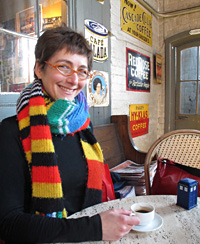I've been working on a bunch of assignment knitting - most of it not yet ready for publication on the blog...
Because I am a sucker for punishment, two of those projects are colourwork. Now, it's not that I don't like colourwork, it's just that it's the sort of knitting that tries my patience - it's slow and careful work, and I am so damn critical of my own technique that I keep undoing perfectly good sections to make them "better". The results are great, but the journey is slow.
And of course, because my knitting plate is full, I inexplicably felt the urge to cast on for a new project.
Something easy-peasy, auto-pilot-appropriate, and fun.
A couple of months ago, I was chatting with a knitter about our stashes. (Comparing stash sizes is a perfectly healthy thing to do, really.) In particular, we were talking about the strange and absurd things hiding in the corners. I confessed to her that I have a soft spot for what I call "big tacky 1980s mohair".
You know, this sort of thing:

(The lime green thing I used as a background is a story for another day.)
So she appeared a few days later with a bag full for me. "Take my mohair - please."
So I did.
It was a load of tremendous black and emerald green mohair, which she'd apparently acquired in a moment of madness at the Textile Museum yardage sale, and had regretted ever since. And it's exactly the sort of thing I love. It's been sitting on my desk since I brought it home, daring me to knit it.
And last weekend inspiration hit. I'm working a sleeveless pullover thing, with a deep v neck and a hood. (Given that I really don't have time to knit anything else right now, I decided to sacrifice the sleeves.) It's loosely inspired by something I saw a kid wearing on the streetcar the other day, a hooded puffy pullover-style vest. ( I think it might also need a kangaroo pocket, but I'll decide that when I get there.)
I'm only allowed to work on it when I really can't work on anything else - when the light isn't good enough, or I have to pay attention to something else. The body is in the round to make it as quick and easy as possible, so even thought it's in black, it's plain sailing so far. Knit knit knit knit knit knit knit.... And I'm having much fun.
(If you've been paying attention to my previous rants, you'll know that I'm not always a fan of things worked in the round - they can be heavy and saggy - but in this case, mohair is so light there is no risk of stretch or sag.)
After swatching, I realized I need an odd needle size, a 5.5mm. (Precisely the one they specified on the ball band, interestingly enough, although why they give a needle size but not a gauge, I don't know...

)
Anyway, I dug around in the cupboard and came out with a needle I haven't used in years - an old Susan Bates aluminum circular. I was thinking I'd just use that to start the project, and then when I got back to a shop I'd pick up an nice slick Addi. But I've kept going on the Susan Bates - it's rocketing along. The needle is just slippery enough, and I have to say the point is a fair bit sharper than the equivalent size Addi Turbo - which you need for a fuzzy sticky yarn like mohair.

So yes, vintage yarn on vintage needles - and I'm loving it!


 Ravelry.
Ravelry.



















